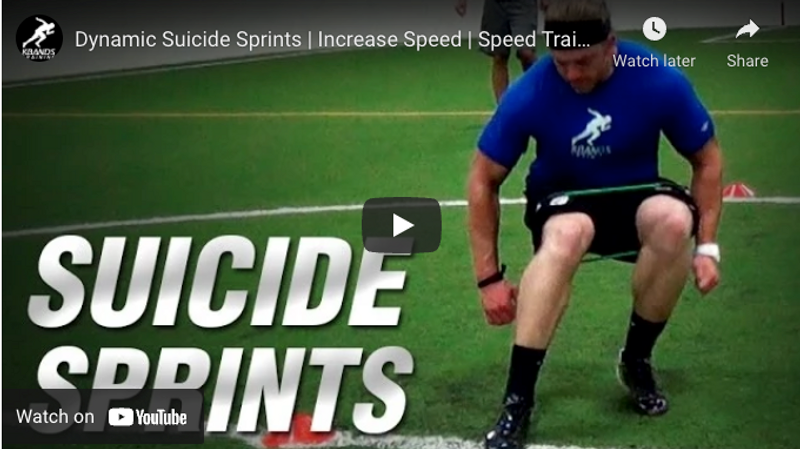Dynamic Suicide Sprints | Sprint Conditioning Workouts
For athletes to compete at their best it is important to optimize each players conditioning. Conditioning drills such as the Dynamic Suicide Sprint Drill will help athletes develop skills in the same way that they will compete on the field. With dynamic acceleration and deceleration throughout each suicide sprint, you will begin building the skills needed for optimal speed gains. Simple linear sprint drills do not allow athletes the ability to develop multidirectional sprint speed, but with the Dynamic Suicide Sprint Drills we can incorporate the essential components of athletic performance.
Sprint Conditioning Workout Set Up
We will begin the Dynamic Suicide Sprints Drill by setting up three speed and agility cones 5 yards apart. The first modification we will be sprinting to the farthest cone and then backpedaling back to the first cone. During the first sequence we will want to make sure that we are driving all the way to the first 10-yard cone. You should never come out of the dig phase before 10 yards. Continue to focus on the leg drive and chest position the entire way to the farthest cone. Utilize a deceleration chop step to slow your sprint speed and move immediately into the backpedal. Once again it is essential to maintain proper form during the backpedal. Backpedaling is done throughout competition and if completed properly, will not slow you down when defending or setting up an offensive attack. Keep the chest slightly forward and make sure that your arms are continuously moving.
Modification 2 | Dynamic Sprint Drills
The second modification will allow us to focus on drop step sprints. We will repeat the first modification, but instead of a full backpedal we will immediately drop step and sprint to the middle cone on the way back. To compete at our best we have to be able to rotate our hips and immediately accelerate to max speed. Build on the first sequence, but take time here to develop the drop step.
Drop Step Key Technique Components
- There are three essential components to the drop step. The first is focusing on hip positioning. As you drop step you must open your hips allowing your body’s center of gravity to shift over the front foot. Staying closed will only slow your acceleration.
- The second is back leg knee drive. You must forcefully drive your back leg forward gaining ground rather than rotating and working in one place. Back leg knee drive will help accelerate you forward.
- The third key to accelerating out of a drop step sprint is arm action. By utilizing your arms you will accelerate your legs. Be very active and explosive with a front arm rip through, as well as a back arm drive, to help rotate your hips and drive your leg forward.
Modification 3 | Advanced Suicide Sprints
The third modification will be the most difficult. First, we will take off sprinting 5 yards. Then accelerate your body moving immediately to the backpedal. As we reach the first cone, we will plant our back leg, shift our weight, and drive again digging to the farthest cone. As we come to the farthest cone, we will chop step slowing our momentum, backpedal to the second cone, and drop step for our sprint out to the left and right.
Be sure that we alternate drop steps on both the second and third modification. This will develop speed dropping to both right and left side.
Suicide Sprint Conditioning With Kbands
Notice throughout the drill you will see Kbands maximizing the results. You will find increased muscle activation throughout this conditioning drill with Kbands. Kbands are an amazing training tool to help activate glutes, hip flexors, and improve stride strength. Resistance training is known to improve stride length and power off the ground. This is an essential component of sprint speed. Not only can Kbands help improve your speed, they will greatly enhance conditioning.
When setting up the proper amount of repetitions and sets during a conditioning workout it is important to train like we compete. This type of conditioning drill is meant to help build explosiveness while improving conditioning. Throughout competition we will need to continuously compete at a high-level, sprinting at our best. By keeping the rest between each conditioning set at a minimum, we will progressively require less rest to maintain 100% intensity. For beginners, complete 2-3 resisted rounds of each of the modifications followed by 1-2 un-resisted reps. For more advanced athletes, complete 5-6 resisted rounds for each of the modifications followed by 1-2 un-resisted rounds. These rep ranges will take some time to get through, but challenge your conditioning and speed each set.

